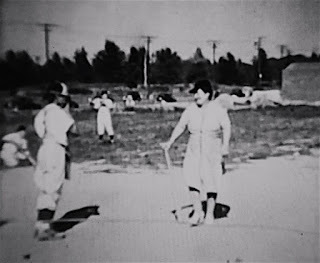Ruth Hanford Morhard's Blog
January 1, 2019
REAL LIFE HEROES!

Josephine Morhard was a rare divorced woman of her time. She had a young son whose father was an alcoholic and became brutal when he drank. She knew her son needed better male role models. Through her baseball leagues, she provided them, for him and for all the boys. Today, outside of their fathers, sports coaches are often the men boys most try to emulate.
Much of a young child's learning comes from observing and imitating adults. Like Josephine, you want your child to have the right role models. Maybe it's a parent, brother, or sister, uncle or aunt--someone who teaches right from wrong, plays ball with them, helps with homework and shows the value of hard work and education. Or it could be a friend, neighbor, teacher or coach. Hopefully, many of them.
Having good role models is important for every child, especially for single moms or dads.
Published on January 01, 2019 10:48
TWO MRS. MORHARDS
My new book Mrs. Morhard and the Boys is about the remarkable Mrs. Josephine Morhard, who created the first organized boys' baseball leagues in the midst of the Great Depression. Her achievement and her approach to boys' baseball were unique. To her baseball was more than a game. It was a tool to help boys grow up right, and she had distinct ideas on how to do just that. Josephine Morhard was the mother-in-law I barely knew.
Decades later I found myself working on a project to help boys grow up right. It was the Boys' Project of Starting Point, a nonprofit early education agency. Using the latest research, I wrote Wired to Move, a practical nonfiction book on how boys' brains work and how teachers and parents can use that understanding to help them become their best. I found that many of Josephine Morhard's Morhard's ideas stood the test of time.
This blog combines the old and the new--ways to nurture young boys (and girls) along with some inspiring stories we think you'll like.
Published on January 01, 2019 10:02
BOYS NEED TO MOVE TO LEARN
In Josephine Morhard's time, kids played outside nearly every day, boys played baseball in the streets and most Moms were housewives. It's different today, but boys still need the movement and exercise of those days. Young boys need to move to learn. Brain research shows us that. Making sure your young boy has lots of time to run and jump and explore--rather than sitting on the couch glued to video games--gets his brain moving, supports learning and fosters good behavior. Check out this article: https://www.nytimes.com/2017/03/21/well/family/why-kids-shouldnt-sit-still-in-class.html?smid=fb-nytimes&smtyp=cur&smvar=wkndbau%3Fsrc%3Dtwr&_r=0
Published on January 01, 2019 09:17
June 9, 2016
MORE ON WHY BOYS NEED TO MOVE!
Check out this article in the Atlantic that talks about how and why children learn through movement It's especially important for boys, who are constantly on the move!
http://www.theatlantic.com/education/archive/2016/05/why-young-kids-learn-through-movement/483408/
http://www.theatlantic.com/education/archive/2016/05/why-young-kids-learn-through-movement/483408/
Published on June 09, 2016 08:45
May 2, 2016
IS YOUR BOY GOING TO KINDERGARTEN IN THE FALL?
Jeremy’s worried about going to kindergarten. It’s in a big brick building. Will he get lost? He likes the idea of riding the school bus, but how will he find his classroom when he gets off? He wonders if he’ll make friends. Will his teacher be nice to him?
 Kindergarten is a new experience, even if your boy has been in preschool. He needs to feel comfortable, not fearful. His first impression can affect his attitude about school and his learning. This is especially important for boys.
Kindergarten is a new experience, even if your boy has been in preschool. He needs to feel comfortable, not fearful. His first impression can affect his attitude about school and his learning. This is especially important for boys.
There are some things you can do to make sure he gets the best start:
• Register him early so he can be comfortable with the school and the school has time to learn about him.
• Present kindergarten as an exciting new experience. Ask him what he thinks school will be like and correct any misunderstandings or fears.
• Talk about and visit his school, bus stop or walk the route to school. Let him meet his teacher.
• Encourage him to be independent. Give him opportunities to follow directions and do tasks on his own.
• Read books, discuss the story and the pictures. Make sure he has chances to use scissors, crayons, pencils, markers, paint and paper. Help him learn his ABCs, numbers and colors.
• Most of all, let him know you're confident that he will do well. And always, always, be positive about school.
Learn more about raising boys in my book Wired to Move: Facts and Strategies for Nurturing Boys in Early Childhood Settings, published by Gryphon House. Available at amazon.com, barnesandnoble.com, gryphon house.com
 Kindergarten is a new experience, even if your boy has been in preschool. He needs to feel comfortable, not fearful. His first impression can affect his attitude about school and his learning. This is especially important for boys.
Kindergarten is a new experience, even if your boy has been in preschool. He needs to feel comfortable, not fearful. His first impression can affect his attitude about school and his learning. This is especially important for boys. There are some things you can do to make sure he gets the best start:
• Register him early so he can be comfortable with the school and the school has time to learn about him.
• Present kindergarten as an exciting new experience. Ask him what he thinks school will be like and correct any misunderstandings or fears.
• Talk about and visit his school, bus stop or walk the route to school. Let him meet his teacher.
• Encourage him to be independent. Give him opportunities to follow directions and do tasks on his own.
• Read books, discuss the story and the pictures. Make sure he has chances to use scissors, crayons, pencils, markers, paint and paper. Help him learn his ABCs, numbers and colors.
• Most of all, let him know you're confident that he will do well. And always, always, be positive about school.
Learn more about raising boys in my book Wired to Move: Facts and Strategies for Nurturing Boys in Early Childhood Settings, published by Gryphon House. Available at amazon.com, barnesandnoble.com, gryphon house.com
Published on May 02, 2016 18:58
March 31, 2016
WHY CAN'T BOYS SIT STILL?
Jeremy is always running or jumping or climbing. When he’s outside, it’s fine. But when he’s inside racing from the kitchen to the dining room to the family room over and over again, it drives his Mom crazy. Especially when she’s trying to get some work done. Why can’t he just sit still?
Does he need to spend so much time running around? The answer is yes; it’s his nature. He needs to move. It turns on his brain. When he’s not active, three-quarters of his brain shuts down. It’s not like that with girls. When their bodies are still, 90 percent of their brains stay active. That’s why it’s often difficult for boys to sit and listen. They fidget. They don’t pay attention. When he’s moving, his brain is alert. And that’s important to learning
So it’s important to give your boy enough time and space to move around and expend his boundless energy. Make sure he gets lots of outdoor play. When he’s inside or the weather is bad, find a special place or activities that allow him to move his body.
You might put an exercise mat in a corner of a room for a mini-gym. Have a special space for racing cars, etc. Play games that allow him to move. Act out characters in a book. Put on some music for marching. Give him jobs to do that require movement.
If you’re choosing a preschool, make sure they allow plenty of outdoor and indoor “movement” time, that they alternate quiet and physical activities and schedule periodic “brain breaks.”
Find out more in Wired to Move: Facts and Strategies for Nurturing Boys in Early Childhood Settings, published by Gryphon House. Available at amazon, Barnes & Noble and other online and retail booksellers.
www.ruthhanfordmorhard.com.
Does he need to spend so much time running around? The answer is yes; it’s his nature. He needs to move. It turns on his brain. When he’s not active, three-quarters of his brain shuts down. It’s not like that with girls. When their bodies are still, 90 percent of their brains stay active. That’s why it’s often difficult for boys to sit and listen. They fidget. They don’t pay attention. When he’s moving, his brain is alert. And that’s important to learning
So it’s important to give your boy enough time and space to move around and expend his boundless energy. Make sure he gets lots of outdoor play. When he’s inside or the weather is bad, find a special place or activities that allow him to move his body.
You might put an exercise mat in a corner of a room for a mini-gym. Have a special space for racing cars, etc. Play games that allow him to move. Act out characters in a book. Put on some music for marching. Give him jobs to do that require movement.
If you’re choosing a preschool, make sure they allow plenty of outdoor and indoor “movement” time, that they alternate quiet and physical activities and schedule periodic “brain breaks.”
Find out more in Wired to Move: Facts and Strategies for Nurturing Boys in Early Childhood Settings, published by Gryphon House. Available at amazon, Barnes & Noble and other online and retail booksellers.
www.ruthhanfordmorhard.com.
Published on March 31, 2016 11:41
WHY CAN’T BOYS SIT STILL?

Jeremy is always running or jumping or climbing. When he’s outside, it’s fine. But when he’s inside racing from the kitchen to the dining room to the family room over and over again, it drives his Mom crazy. Especially when she’s trying to get some work done. Why can’t he just sit still?
Does he need to spend so much time running around? The answer is yes; it’s his nature. He needs to move. It turns on his brain. When he’s not active, three-quarters of his brain shuts down. It’s not like that with girls. When their bodies are still, 90 percent of their brains stay active. That’s why it’s often difficult for boys to sit and listen. They fidget. They don’t pay attention. When he’s moving, his brain is alert. And that’s important to learning
So it’s important to give your boy enough time and space to move around and expend his boundless energy. Make sure he gets lots of outdoor play. When he’s inside or the weather is bad, find a special place or activities that allow him to move his body.
You might put an exercise mat in a corner of a room for a mini-gym. Have a special space for racing cars, etc. Play games that allow him to move. Act out characters in a book. Put on some music for marching. Give him jobs to do that require movement.
If you’re choosing a preschool, make sure they allow plenty of outdoor and indoor “movement” time, that they alternate quiet and physical activities and schedule periodic “brain breaks.”
Find out more in Wired to Move: Facts and Strategies for Nurturing Boys in Early Childhood Settings, published by Gryphon House. Available at amazon, Barnes & Noble and other online and retail booksellers. www.ruthhanfordmorhard.com.
Published on March 31, 2016 10:40
February 18, 2016
My interview "Getting Boys to Love School" on Education R...
My interview "Getting Boys to Love School" on Education Radio is now live on the Bam Radio Network . Hosted by Rae Pica, and also featuring Richard Hawkins. Rae Pica his the author of many books on education. Richard is the co-author of "Reaching Boys: Teaching Boys" and former headmaster of Cleveland's University School. You'll find the interview here:http://www.bamradionetwork.com/…/3708-getting-boys-to-love-…
Getting Boys to Love SchoolRae Pica with Richard Hawley, Ruth Hanford Morhard, Heidi Veal Boys continue to struggle in our educational system. In this segment, we look at proven strategies to get boys to love school. Follow: @bamradionetwork @raepica1 @ruthmhrm @vealheidi
Boys continue to struggle in our educational system. In this segment, we look at proven strategies to get boys to love school. Follow: @bamradionetwork @raepica1 @ruthmhrm @vealheidi
#edchat #edreform #ece #earlyed #AskingWhatIf
Getting Boys to Love SchoolRae Pica with Richard Hawley, Ruth Hanford Morhard, Heidi Veal
 Boys continue to struggle in our educational system. In this segment, we look at proven strategies to get boys to love school. Follow: @bamradionetwork @raepica1 @ruthmhrm @vealheidi
Boys continue to struggle in our educational system. In this segment, we look at proven strategies to get boys to love school. Follow: @bamradionetwork @raepica1 @ruthmhrm @vealheidi #edchat #edreform #ece #earlyed #AskingWhatIf
Published on February 18, 2016 19:47
February 4, 2016
INTERVIEW ON BOYS LEARNING

I did an interview this afternoon on the BAM Radio Network-WSCR with authors Rae Pica and Richard Hawkins. The topic was "Ensuring Success for Boys." Rae hosts the show and is the author of numerous books on education. Richard is the co-author of "Reaching Boys: Teaching Boys" and is also the former Headmaster of University School in Cleveland. I spoke about my book "Wired to Move: Facts and Strategies for Nurturing Boys in Early Childhood, focusing mainly on the importance of incorporating movement in the classroom. It'll be up on the internet soon.
Watch for it.
Published on February 04, 2016 15:20
January 11, 2016
RAISING BOYS: A TIP FOR THE NEW YEAR
Frustrated Because He Doesn’t Follow Directions?
Here’s Why and What to Do
You’re in a hurry. You need to get groceries. Your five year-old son is zooming the remote–controlled car he got for Christmas back and forth from the great room into the kitchen, where you’re trying to clean up after lunch. You nearly trip over it. You tell him to pick the car up, put it back on the shelf in his room and get his coat on so you can go. He grabs the toy and heads toward his room. Halfway there, he drops to the floor and starts playing with it again. You feel like screaming. Why does he always do that? Why can’t he follow directions?
Well, he can. Just not the way you expect. Boys are best at focusing on a single task at a time. That’s the way their brains are built. When they’re young, it’s hard for them to remember more than one direction at a time. Your best bet is to tap him lightly on the shoulder to get his attention. Give him the first instruction and ask him to repeat it. Wait until he has completed each task before you give him the next one. Gradually, he’ll learn to follow multiple directions at a time. You’ll find more information in my book Wired to Move: Facts and Strategies for Nurturing Boys in Early Childhood Settings Wired to Move: Facts and Strategies for Nurturing Boys in an Early Childhood Setting, published by Gryphon House. Available at online and retail booksellers.
~RuthRuth Hanford Morhard
See www.ruthhanfordmorhard.com
www.ruthhanfordmorhard.blogspot.com
Here’s Why and What to Do
You’re in a hurry. You need to get groceries. Your five year-old son is zooming the remote–controlled car he got for Christmas back and forth from the great room into the kitchen, where you’re trying to clean up after lunch. You nearly trip over it. You tell him to pick the car up, put it back on the shelf in his room and get his coat on so you can go. He grabs the toy and heads toward his room. Halfway there, he drops to the floor and starts playing with it again. You feel like screaming. Why does he always do that? Why can’t he follow directions?
Well, he can. Just not the way you expect. Boys are best at focusing on a single task at a time. That’s the way their brains are built. When they’re young, it’s hard for them to remember more than one direction at a time. Your best bet is to tap him lightly on the shoulder to get his attention. Give him the first instruction and ask him to repeat it. Wait until he has completed each task before you give him the next one. Gradually, he’ll learn to follow multiple directions at a time. You’ll find more information in my book Wired to Move: Facts and Strategies for Nurturing Boys in Early Childhood Settings Wired to Move: Facts and Strategies for Nurturing Boys in an Early Childhood Setting, published by Gryphon House. Available at online and retail booksellers.
~RuthRuth Hanford Morhard
See www.ruthhanfordmorhard.com
www.ruthhanfordmorhard.blogspot.com
Published on January 11, 2016 11:04



